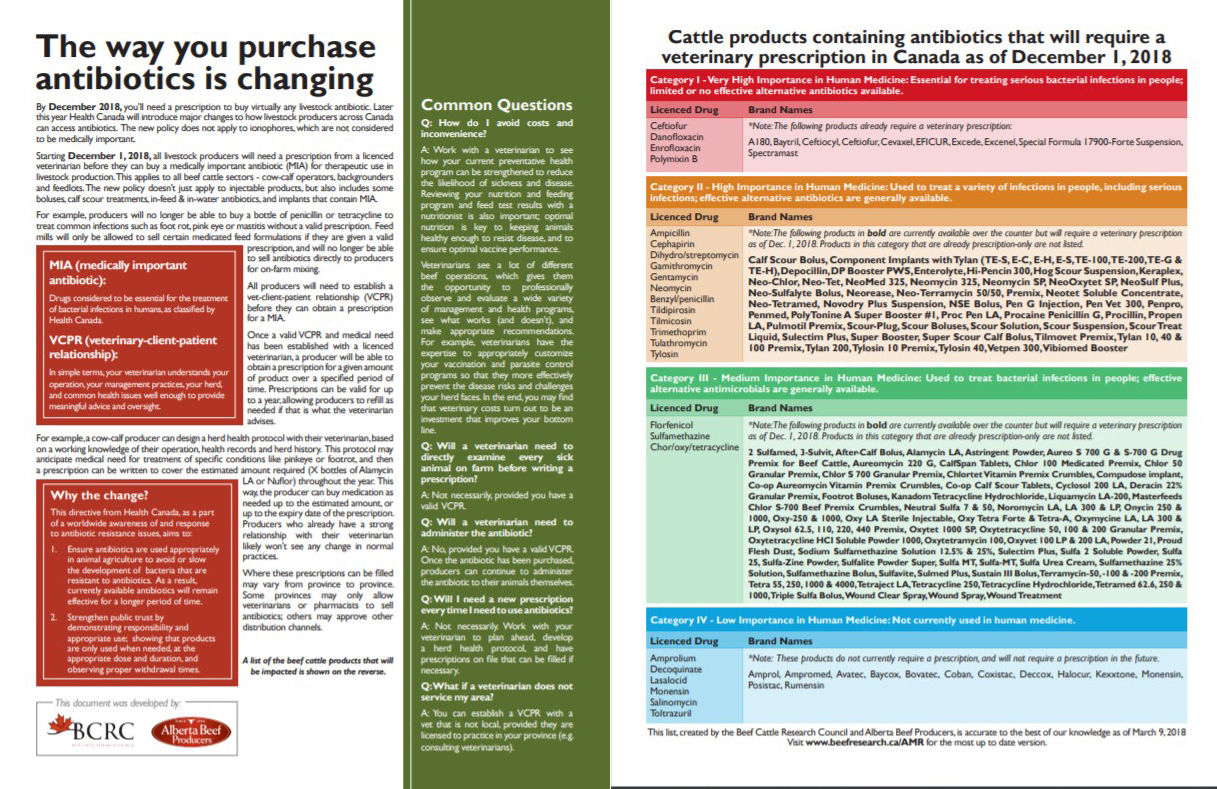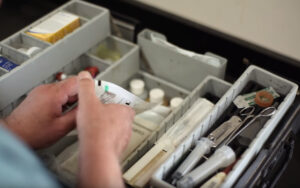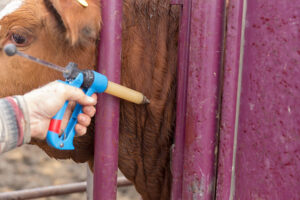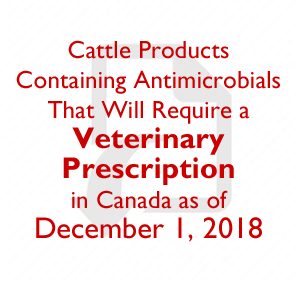This December, you’ll need a prescription to buy virtually any livestock antibiotic
Note: Updated version published here September 10, 2018.
If you haven’t done so already, the first few months of 2018 would be an excellent time to develop a relationship with a beef veterinarian.

Starting late in 2018, Health Canada is introducing a couple of important changes affecting the way animal antibiotic products can be accessed by producers. And having an established Veterinary-Client-Patient Relationship (VCPR) will be an important part of a smooth transition. (see sidebar below)

The key point is, starting Dec. 1, 2018, all livestock producers will need a prescription from a licenced veterinarian, before they can buy a medically important antibiotic (MIA) for therapeutic use in livestock production. This applies to all beef cattle sectors using antibiotics — cow-calf operators, feedlots and feedmills (and really all sectors of animal agriculture including beef, dairy, hogs, sheep, horses, fish and even bees). The new policy doesn’t just apply to injectable products, but also includes some boluses and calf scour treatments, and Component and Compudose implants. At the same time, the new policy does not apply to certain antimicrobials such as the ionophores, which are not considered to be medically important in managing disease in humans.
Prescription Needed
Producers who are used to picking up a bottle of penicillin or tetracycline at their local farm supply store to treat common infections such as foot rot, pink eye or mastitis, will no longer be able to do so. Many of the antibiotics used for animals are already only available through prescription. However, some common products traditionally available without a prescription through farm and feed supply outlets will soon require a prescription. In the feedlot sector, commonly used in-feed products such as tylosin and tetracycline have been available without prescription. Starting December 1st a prescription will be needed for all these medically important antibiotic products.
“The new policy deeming these products to have prescription status is happening at the federal level, but implementing the policy is provincial jurisdiction,” says Wendy Wilkins, a veterinarian with the livestock branch of the Saskatchewan Ministry of Agriculture. “Everyone will need a prescription, but where they take that prescription to be filled may vary from province to province.”
For cow-calf producers in Alberta and Saskatchewan, for example, under the current legislation products will only be available from a veterinary clinic or licenced pharmacist. The final distribution system in Alberta is still being discussed. Commercial feedmills will be able to manufacture and sell MIA in feed pursuant to a veterinary prescription under current provincial regulation in macro premix, micro premix, supplement or complete feed formulations— but the role of feed dealers is still unclear.
If you have established the VCPR— that veterinary/client/patient relationship — with a licensed veterinarian, for example, a producer will be able to obtain a prescription for a given amount of product for perhaps a full year (depending on the circumstance) enabling them to buy it as needed and for use according to advice of the veterinarian.
For example, a cow-calf producer in consultation with their veterinarian can determine, based on their records and herd history, they will likely need X-number of bottles of tetracycline (like Liquamycin or Bio-mycin) to treat pinkeye, or X-number of bottles of Nuflor to treat footrot — throughout the year. A prescription can be written to cover that estimated need and then the producer can buy medication as needed up to the estimated amount, or up to the expiry date of the prescription. Producers who already have a veterinary/client relationship likely won’t see any change in normal practices.
“I believe this is good legislation and the right thing to do for any industry that produces food,” says Craig Dorin, a veterinarian with Veterinary Animal Health Services (VAHS) in Airdrie, just north of Calgary. “It is important that antibiotics used in food animals have an appropriate level of regulation.”
Addressing the AMR Issue
The underlying issue that has brought about these Health Canada changes is the increasing concern in recent years about development of antimicrobial resistance (AMR) in bacteria in animals as well as in humans. Anyone who has grown annual crops in the past 25 years is well aware of efforts to prevent and reduce development of herbicide resistance in weeds. Well, it is a very similar issue at play when it comes to the use of antibiotics used in animal agriculture — a concern over AMR.
Research indicates that AMR is developing in beef cattle; some antimicrobials used on the farm or in the feedlot are not working as well as they once did. Antimicrobial resistance is also developing in human patients, though there is no compelling evidence that antimicrobial use in Canadian livestock production is contributing to AMR in human medicine.
Research indicates that AMR is developing in beef cattle; some antimicrobials used on the farm or in the feedlot are not working as well as they once did. Antimicrobial resistance is also developing in human patients, though there is no compelling evidence that antimicrobial use in Canadian livestock production is contributing to AMR in human medicine.
A Vet/Client Relationship:
So what is a Veterinarian-Client-Patient-Relationship (VCPR)? In most cases it isn’t a formal written agreement and in essence it is a relationship that develops between a veterinarian and a producer — the veterinarian knows the operator, visits the farm or ranch to get an understanding of the operation, sees how animals are cared for and is confident the producer will be responsible in following medical advice and properly use any products as directed. Establishing a VCPR starts with a producer contacting a veterinarian, sitting down to discuss their livestock operation and provide some record of animal health treatment protocols. Depending on the veterinarian policy it may or may not involve a farm visit.
For example, the Alberta Veterinary Medical Assoc. has formalized five points, which constitutes a VCPR. Their requirements include:
1. The veterinarian has assumed the responsibility for making clinical judgments regarding the health of the patient (livestock) and the client has agreed to follow the veterinarians’ instructions.
2. The veterinarian has sufficient knowledge of the patient to initiate at least a general or preliminary diagnosis of the medical condition of the patient. This means that the veterinarian is personally acquainted with the keeping and care of livestock by virtue of a timely examination of the herd or individual animals by the veterinarian, or medically appropriate and timely visits by the veterinarian to the farm or ranch.
3. The veterinarian is readily available for follow-up evaluation or has arranged for the following: veterinary emergency coverage, and continuing care and treatment.
4. The veterinarian provides oversight of treatment, compliance, and outcome.
5. Patient records are maintained.
A Veterinarian-Client-Patient Relationship exists when your veterinarian knows the livestock operation well enough to be able to diagnose and treat any medical conditions animals develop. The producer’s part of the VCPR is allowing the veterinarian to take responsibility for making clinical judgments about animal health, asking questions to make sure you understand, and following your veterinarian’s instructions. The veterinarian’s part of the VCPR involves making those judgments; accepting the responsibility for providing animals with medical care; keeping a written record of that medical care; advising you about the benefits and risks of different treatment options; providing oversight of treatment, compliance (your follow-through on their recommendations) and outcome; and helping you know how to get emergency care for animals if the need should arise.

For more details Lehman points to:
- US CDC report (see page 11), and
- UK AMR Review (Executive Summary):
These changes in Health Canada policy have two main objectives:
- To better manage antimicrobial use and hopefully even reduce the amount of antibiotics used in animal agriculture (food-animal production) with the aim of reducing or slowing the development of AMR in animal pathogens.
- With a complexity of factors contributing to AMR, the new policies will demonstrate the proper stewardship of the agriculture industry in being responsible in the proper use of antibiotics — showing that products are only used when needed, at the appropriate dose and within the recognized withdrawal times. It will help stem a growing public perception that the livestock industry casually uses high rates of antibiotics without regard for animal, environmental or human health conditions.
“It’s really about bringing the livestock industry in line with the way antibiotics are handled on the human health side,” says Lehman. “You need a prescription.”
Industry Stewardship
The change in legislation isn’t about bringing more business to the veterinarian’s door and creating more hoops for producers. It’s about demonstrating proper management and control of these medicines for the sake of both animal and human health.
Murray Jelinski, a professor in large animal clinical sciences at the Western College of Veterinary Medicine in Saskatoon, SK says no one should be surprised these changes are coming.
“Whether anyone thinks it is a good or bad move is really irrelevant,” says Jelinski. “Europe, for example, is already ahead of Canada in this regard, and other countries around the world are moving in this direction — this is really a global movement hence it is incumbent upon Canada to do its part.
“Personally, I think it is good policy,” he says. “Many producers will be fine with it. Some will be cynical and see it as a vet grab to create a monopoly in the market. However competition will still remain within the marketplace. Ultimately, these changes reflect where the world is headed with respect to the prudent use of antimicrobials whether they be in humans or animals.”
Jelinski notes that some have described the increasing rates of antimicrobial resistance (to currently used medicines) as “one of humanity’s greatest concerns”. Particularly on the human health side, as the so-called “superbugs” develop there are a limited number of options in the medical toolbox to control them.
He also points to the movement or interest in the “One Health” concept — The One Health concept recognizes that the health of people is connected to the health of animals and the environment. “While there can be considerable debate about the connection of antibiotic use in livestock and the effect it has on antimicrobial resistance in human medicine it is really a moot point,” says Jelinski. “The livestock industry needs to demonstrate its commitment to being part of the solution.”

Some Policy Details
Getting back to the policy changes — all producers will need to establish the vet-client (VCPR) relationship before they can obtain a prescription for a medically important antibiotic. And each provincial jurisdiction will decide on the dispensing system.
Dorin, with VAHS in Airdrie says most of the details for cow-calf producers in Alberta have been sorted out. On the feedlot side, manufacturers will be able to sell MIA to commercial feedmills that will then be able to mix them into feed and sell to a feedlot pursuant to a veterinary prescription. On-farm feed mixers, with a prescription, can buy micro and macro premixes, supplements and complete feed from a commercial feedmill or from a licensed veterinarian or pharmacist under current regulation.
Some of the common feedlot products covered by the new feed policy include tetracyclines such as chlortetracyclines and oxytetracylines, — and tylosin products. These are broad-spectrum antibiotics that are formulated in supplements at the feedmill and then included in feedlot rations. Some feedlots have the technology to allow them to purchase the antibiotics in the raw form and formulate them into the ration in their mill system.
“A prescription will still be needed, but there is still ongoing discussion of how or who will actually be dispensing the products,” says Dorin. “The details have yet to be worked out.”
Import Antibiotics Covered Too
A couple other changes included in Health Canada regulations include new restrictions on importing antibiotics manufactured outside of Canada. This change actually came into effect Nov. 13, 2017. It’s already in place.

The new regulations cover what’s known as own use importation (OUI) products. Livestock producers have been able to import antibiotics and other animal health products manufactured outside of Canada. As of Nov. 13, 2017, producers can no longer import medically important antibiotic products — that means no antibiotics can be imported by producers themselves, and producers will need a prescription to access those products in Canada.
The regulations do allow for producer access to a range of veterinary drugs listed on Health Canada’s List B, which can still be imported by producers themselves for their own use, but not sold. This includes pour-on endectocides and growth implants such as Cydectin, Ivomec , Ralgro and Synovex to name a few. They must be finished products in commercial form, with proper packaging and registered for use in Canada.
In preparing for the coming changes in policy Canadian drug manufacturers voluntarily agreed to withdraw growth promotion claims for the MIA. New labelling will include the prescription symbol and no growth promotion claims to meet the December 1st timeframe for change.
“Overall the new regulations and policies align Canada with that of other developed countries around the world use of antimicrobials,” says Jean Szkotnicki, president at the Canadian Animal Health Institute. “What we are seeing is a global thrust toward the responsible use of antimicrobial products.”
She says the growing awareness of using products responsibly has just in the past year already resulted in an 11 per cent reduction in the use of antibiotic products in Canada. There has been a similar 17 per cent decline in the U.S.
Producers will need a plan
As the new prescription policy comes into effect it is important to get the word out to producers, says Karin Schmid, beef production specialist with Alberta Beef Producers.
“It is important for producers to plan accordingly,” says Schmid. “Producers will need to establish the veterinary-client-patient relationship in order to obtain a prescription and maintain timely access to treatment of their animals.”

It is all part of having the veterinarian involved in herd health planning, she says. “Producers can talk to their veterinarian, explain some of the common herd health challenges they may encounter. Perhaps pink eye is a common problem at certain times of the year or in certain pastures, for example — so as part of the herd health plan you can anticipate some of those needs and have the prescriptions and medications in place so they are on hand when you need them. I am not sure how many producers are aware of the new policy and its implications of needing to have a relationship with a veterinarian to be able to access these medically important antibiotics.”
Having a VCPR and prescription in place are key elements in being prepared. If a producer discovers on a Saturday afternoon a case of pink eye in an animal that needs to be treated, for example, they won’t have the option to run to a local farm supply outlet and pick up a bottle of penicillin. It also means, without a VCPR and prescription in place, a producer can’t just stop in at a veterinary clinic and pick up an antibiotic from staff if there is no veterinarian on duty.
In Saskatchewan, Wendy Wilkins says a major part of her job as a veterinarian over the coming months will be to explain the regulations and changes to producers.
She says it will be important to explain the changes to all sectors of food-animal production. While beef, dairy, poultry, swine, horse owners and sheep producers are among the most obvious livestock sectors, she recently fielded questions about fish and also from beekeepers. “So there may be other smaller sectors that need to be informed that we haven’t even thought about,” she says.
“For many of the larger and commercial beef producers there shouldn’t be much of a change,” says Wilkins. “But there are many smaller operations that perhaps haven’t been involved with a local veterinarian on a regular basis and they will need to establish the VCPR. It should be noted there has always been a requirement for a VCPR for producers buying prescription medications from a veterinarian — so that’s not new. But for those who have been buying antibiotics from various retailers without a prescription they will now need to go through a veterinarian.”
- Download: 2-page printer-friendly handout [PDF]
- Download: List of Cattle Products Containing Antimicrobials That Will Require a Veterinary Prescription in Canada as of December 1, 2018 [PDF]
Click here to subscribe to the BCRC Blog and receive email notifications when new content is posted.
The sharing or reprinting of BCRC Blog articles is welcome and encouraged. Please provide acknowledgement to the Beef Cattle Research Council, list the website address, www.BeefResearch.ca, and let us know you chose to share the article by emailing us at info@beefresearch.ca.
We welcome your questions, comments and suggestions. Contact us directly or generate public discussion by posting your thoughts below.
